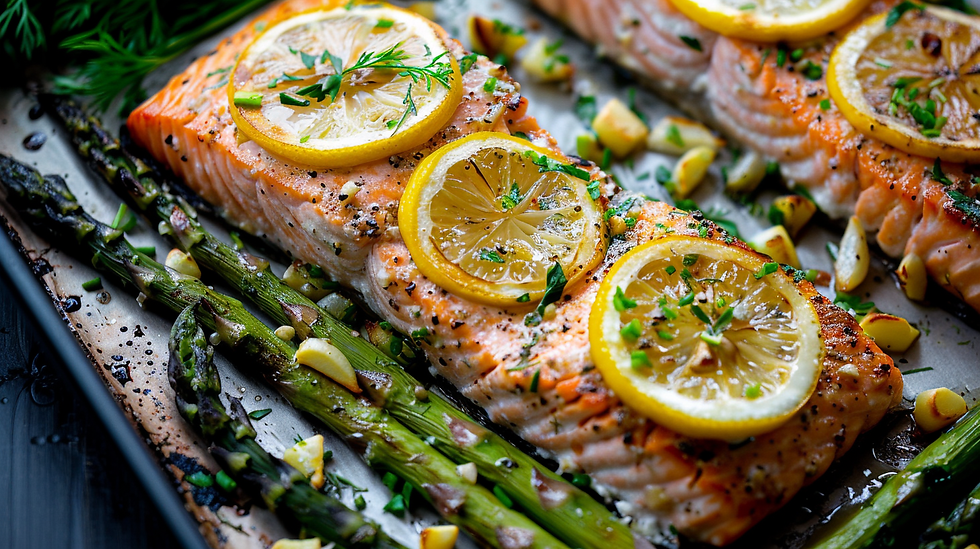Healing Delights: Health Benefits of a Balanced Diet for Bipolar Disorder
- The Carrington Clinic

- Jun 21, 2024
- 4 min read
Updated: Jun 27, 2024

Healing Delights: Managing Bipolar Disorder Through Nutrition
Bipolar disorder is a complex mental health condition characterized by extreme mood swings, including emotional highs (mania or hypomania) and lows (depression). These fluctuations can significantly impact energy levels, activity, and the ability to carry out daily tasks. While medication and therapy are crucial components of managing bipolar disorder, dietary choices can also play a supportive role in alleviating symptoms and promoting overall well-being.
Symptoms of Bipolar Disorder
Individuals with bipolar disorder may experience a range of symptoms, including:
Periods of elevated mood, energy, and activity levels.
Periods of persistent sadness, hopelessness, or loss of interest.
Sleep disturbances, from excessive sleeping to insomnia.
Difficulty concentrating.
Impulsive or risky behavior.
Social withdrawal.
Nutritional Recommendations
Certain foods are known to help alleviate bipolar disorder symptoms due to their nutritional properties and specific compounds. Here are some recommended options, along with alternatives for those with allergies or preferences:
1. Omega-3 Fatty Acids (Salmon, Tuna, Walnuts)
Benefits: Support brain health and mood regulation.
Alternatives: Algae oil, chia seeds.
2. Complex Carbohydrates (Whole Grains, Fruits, Vegetables)
Benefits: Provide steady energy and support overall health.
Alternatives: Gluten-free grains like quinoa or brown rice.
3. Lean Proteins (Chicken, Turkey, Beans)
Benefits: Provide essential amino acids and support muscle health.
Alternatives: Plant-based proteins like tofu or lentils.
4. Vitamins and Supplements
Omega-3 Fatty Acids: 1,000-2,000 mg per day (Supports brain health).
Vitamin D: 600-800 IU per day (Regulates mood).
Folate: 400 mcg per day (Supports brain function).
Nutrient-Rich Grocery Store Essentials
Omega-3 Fatty Acids
Vegetarian Sources: Algae oil, chia seeds, flaxseeds
Nuts: Walnuts (ensure they are not cross-contaminated with gluten)
Complex Carbohydrates
Gluten-Free Options: Quinoa, brown rice, gluten-free oats
Fruits and Vegetables: Cherry tomatoes, cucumbers, bell peppers, red onions, berries (blueberries, strawberries, raspberries)
Lean Proteins
Meat Options: Chicken breast, turkey breast
Plant-Based Options: Tofu, lentils, beans
Vitamins and Supplements
Omega-3 Supplements: Algae-based omega-3 capsules
Vitamin D: Vitamin D supplements (ensure they are gluten-free)
Folate: Folate supplements (ensure they are gluten-free)
Snacks
Omega-3 Rich Snacks:
Chia seed pudding (made with almond milk)
Flaxseed crackers (gluten-free)
Walnuts (individual packs for convenience)
Complex Carbohydrate Snacks:
Gluten-free granola bars (made with oats and nuts)
Rice cakes (ensure they are labeled gluten-free)
Fresh fruit (berries, cherry tomatoes, cucumber slices)
Lean Protein Snacks:
Grilled chicken strips
Tofu bites
Lentil soup (canned or homemade)
Alternative Foods
Gluten-Free Alternatives:
Gluten-free bread (made from rice, quinoa, or other gluten-free grains)
Gluten-free pasta (made from rice, corn, or quinoa)
Gluten-free crackers (made from rice or nut flours)
Shellfish-Free Alternatives:
Use chicken or tofu instead of salmon in recipes
Plant-based protein sources like lentils, chickpeas, and black beans
Delicious 30-Minute Recipes
To help you incorporate these nutritional recommendations into your daily routine, here are three delicious and easy-to-make recipes for breakfast, lunch, and dinner.
Breakfast: Overnight Oats with Chia Seeds and Berries

Ingredients:
1 cup rolled oats
1 cup almond milk (or any milk of choice)
2 tablespoons chia seeds
1 tablespoon honey or maple syrup
1/2 cup mixed berries (blueberries, strawberries, raspberries)
1/4 teaspoon vanilla extract
Instructions:
In a mason jar or bowl, combine the oats, almond milk, chia seeds, honey, and vanilla extract.
Stir well to ensure all ingredients are mixed.
Cover and refrigerate overnight.
In the morning, top with mixed berries and enjoy!
Benefits:
This recipe is rich in omega-3 fatty acids from chia seeds, complex carbohydrates from oats, and antioxidants from berries, making it a perfect start to your day.
Lunch: Quinoa and Vegetable Salad

Ingredients:
1 cup quinoa, rinsed
2 cups water
1 cup cherry tomatoes, halved
1 cucumber, diced
1 bell pepper, diced
1/4 cup red onion, finely chopped
1/4 cup feta cheese, crumbled (optional)
2 tablespoons olive oil
1 tablespoon lemon juice
Salt and pepper to taste
Fresh parsley, chopped (for garnish)
Instructions:
In a medium saucepan, bring quinoa and water to a boil. Reduce heat, cover, and simmer for 15 minutes or until water is absorbed.
Fluff quinoa with a fork and let it cool.
In a large bowl, combine the cooled quinoa, cherry tomatoes, cucumber, bell pepper, red onion, and feta cheese.
Drizzle with olive oil and lemon juice, and season with salt and pepper.
Toss to combine and garnish with fresh parsley.
Benefits:
This salad provides complex carbohydrates from quinoa and a variety of vitamins and minerals from the vegetables, supporting overall health and steady energy levels.
Dinner: Lemon Garlic Salmon with Asparagus

Ingredients:
2 salmon fillets
1 bunch asparagus, trimmed
2 tablespoons olive oil
2 cloves garlic, minced
1 lemon, sliced
Salt and pepper to taste
Fresh dill or parsley for garnish
Instructions:
Preheat the oven to 400°F (200°C).
Place the salmon fillets and asparagus on a baking sheet lined with parchment paper.
Drizzle with olive oil and sprinkle with minced garlic, salt, and pepper.
Arrange lemon slices on top of the salmon and asparagus.
Bake for 15-20 minutes, or until the salmon is cooked through and the asparagus is tender.
Garnish with fresh dill or parsley before serving.
Benefits:
This dish is rich in omega-3 fatty acids from the salmon and provides essential vitamins and minerals from the asparagus, supporting brain health and mood regulation.
Conclusion
By incorporating these nutritious foods into your diet, you can help manage the symptoms of bipolar disorder and promote overall well-being. Remember to consult with a healthcare professional before making any significant changes to your diet or supplement regimen.
For expert guidance on mental health and wellbeing, consider reaching out to The Carrington Clinic. Visit our website at The Carrington Clinic to learn more about our services and how we can help you or your loved ones navigate the challenges of mental health.




Comments